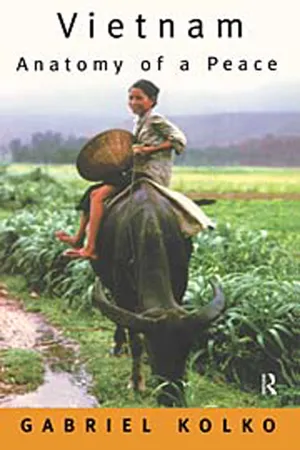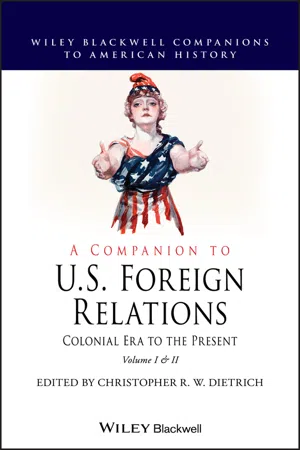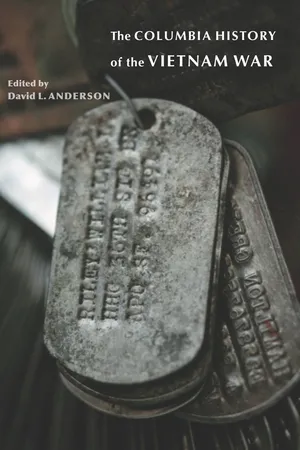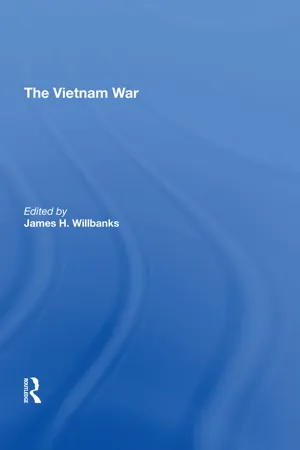History
The Vietnam War
The Vietnam War was a conflict that took place in Vietnam, Laos, and Cambodia from November 1, 1955, to the fall of Saigon on April 30, 1975. It was a prolonged and costly struggle between communist forces, supported by the Soviet Union and China, and non-communist forces, primarily supported by the United States. The war resulted in significant loss of life and had a lasting impact on the region.
Written by Perlego with AI-assistance
Related key terms
8 Key excerpts on "The Vietnam War"
- eBook - ePub
- Gabriel Kolko(Author)
- 2008(Publication Date)
- Routledge(Publisher)
IntroductionThe legacy of warThe Vietnam War was the twentieth century’s longest international conflict. In a world that has endured unimaginable protracted violence and suffering in vast areas, The Vietnam War was among the most devastating on people’s lives. To grasp the enormous magnitude of this epic tragedy defies both words and imagination.All wars profoundly transmute social and human realities, and it is only with this pervasive truth in mind that we can begin to comprehend the whole course of Vietnam’s history, not only over the thirty years of the war but, above all, after it ended in 1975. There is a direct continuity between the war’s overwhelming heritage and the two decades that followed it. We cannot understand the anatomy of the peace unless we fully appreciate the war’s incalculable physical, human, and psychological damage, how its legacies defined the Communist party’s structure and ideology, and left Vietnam destroyed and burdened.It is a consummate irony – and tragedy – that many of Vietnam’s Communist leaders, after a war that involved monumental sacrifices, within a decade of its end forgot their own history They, of all people, could least afford to do so. For memory is not only an absolute precondition for fathoming the human condition and history’s lessons, but above all for confronting today’s challenges.Although we are obliged to employ statistics to measure the war’s impact, numbers can never capture the tears, anxieties, and repeated losses that the Vietnamese people suffered. Such experiences mock all efforts to plumb or describe them, and all wars must, however great our sensibilities, resist our attempts to comprehend them. Only those who have experienced or witnessed them can begin to sense their searing realities. Monumental human and social tragedies cannot be computed, and whenever we rely on statistics – nearly all of which are, at the very best, finite approximations – we also confess our inability to grasp realities that are far more profound and elusive. There are never census takers in wars in which civilians become principal targets; the victims are unable to keep records, and the perpetrators do not wish to do so. Crimes against humanity – and Vietnam was one of all too many in this century – are often virtually invisible. - eBook - ePub
- Loramy Gerstbauer(Author)
- 2016(Publication Date)
- Routledge(Publisher)
The Vietnam War was the most divisive period in the United States during the twentieth century. The war caused intense debate over national identity, calling into question the foundational myth of American exceptionalism, which portrays the United States as a pure, selfless, and nonimperial nation (Fry 2006, 175). The debate over Vietnam continues to affect U.S. foreign policy long after 1975, and the lessons of Vietnam were evoked in the Persian Gulf War, the 2003 Iraq war, and, as noted already, in Obama’s response to the Syria conflict in 2014.The Vietnam War extended beyond the nation of Vietnam into neighboring Laos and Cambodia. For the Vietnamese, the conflict also extended beyond the timeframe of U.S. involvement, which was from 1954–1973, heightening in 1965 with an air campaign and then ground troops. Although The Vietnam War involved different theaters in Southeast Asia, the focus of this analysis is on the relations between Vietnam and the U.S. only. The analysis also puts little emphasis on reconciliation between North and South Vietnam, except where it factors into U.S.-Vietnamese relations.A Cold War Proxy War
U.S. goals in the war must be perceived through the lens of the Cold War. The U.S. sought to reduce the threat of Sino-Soviet domination of Asia, to thwart “wars of national liberation” in developing nations, and to otherwise halt Communism and its threat to peace and stability in Asia. The U.S. also expressed a goal of promoting democracy and free trade and investment (Kenny 2002, 129). The fear of collapsing dominoes of Communism was real. John F. Kennedy cautioned that “Vietnam represents the cornerstone of the Free World in Southeast Asia, the keystone to the arch, the finger in the dike. Burma, Thailand, India, Japan, the Philippines, and obviously, Laos and Cambodia are among those whose security would be threatened if the red tide of Communism overflowed into Vietnam” (14). Likewise, President Lyndon Johnson viewed Vietnam through the lens of the Communist tide. He justified his 1965 decision to send troops into South Vietnam in terms of a “Jakarta-Hanoi-Beijing-Pyongyang axis, with Cambodia probably to be brought in as a junior partner and Laos to be merely absorbed by the North Vietnamese and the Chinese” (117). The war was also viewed as a defense of South Vietnam against the aggression of Communist North Vietnam. According to President Johnson, “Our purpose in Vietnam is to prevent the success of aggression. It is not conquest; it is not empire; it is not foreign bases; it is not domination. It is, simply put, just to prevent the forceful conquest of South Vietnam by North Vietnam” (14). The degree to which the war can be understood as one of northern aggression is still debated. To what degree was there genuine rebellion in South Vietnam, with South Vietnamese Communists rebelling against the South Vietnamese government, and to what degree was North Vietnam controlling these entities in the South such that the conflict was more of a North/South Vietnamese conflict? (Nguyen 2006). - eBook - ePub
The Vietnam War
A Study in the Making of American Policy
- Michael P. Sullivan(Author)
- 2021(Publication Date)
- The University Press of Kentucky(Publisher)
None of these large-scale perspectives is meant to explain the specific occurrence of The Vietnam War, when it occurred, or when it ended. Rather, these perspectives are an attempt to step back and put some envelopes around The Vietnam War and America’s involvement in order to bring to bear the broadest possible perspective.The Vietnam War AND THE COLD WAR
One generally and popularly accepted explanation of the United States’ involvement in The Vietnam War is that it flowed from the larger Cold War pitting the two largest and most powerful nations coming out of World War II against each other. While the bipolarity that emerged in the late 1940s and early 1950s was later to fade, during much of that crucial period a popular interpretation of world politics pitted the socialist, atheist, Eastern-bloc countries against the capitalist, religiously oriented, Western countries. Although it was not a complete split (the United States even provided aid to some Eastern European, Communist-bloc countries) still the political rhetoric and popular perception at the time was of a highly bipolarized world.It is interesting, then, to see exactly how The Vietnam War fits within that broader context of the East-West struggle. A brief historical review shows the Cold War to be not one single, static entity, but rather a changing, dynamic, fluctuating, interaction process. The six-year period from 1946 to 1952 was a relatively “hot” period in East-West relations, including the Russian takeover of Eastern Europe, the Berlin crisis of 1948, the formation of NATO, the Marshall Plan, and the outbreak of the Korean War. This was followed by a period of relative détente, from about 1953 to perhaps 1956, with the occurrence of the stalemate and then the cease-fire of the Korean War in 1953, the 1954 Geneva Conference to consider a settlement to the Vietnam situation, the Geneva summit of 1955, and the so-called Spirit of Camp David. The next hot period lasted from about 1956 to about 1963, and included the Russian invasion of Hungary in 1956, the downing of an American U-2 in Russia and the subsequent cancellation of the 1960 summit meeting, the Bay of Pigs, Kennedy’s bellicose speech following his summit meeting with Khrushchev in 1961, erection of the Berlin Wall of 1961, and finally the Cuban Missile Crisis of late 1962. The one exception during this period was 1959, when there was much-heralded talk of détente between East and West, which, of course, was followed by the breakup of the planned 1960 summit meeting between Premier Khrushchev and President Eisenhower because of the Russian downing of the American U-2 spy plane. - eBook - ePub
America and the Vietnam War
Re-examining the Culture and History of a Generation
- Andrew Wiest, Mary Kathryn Barbier, Glenn Robins(Authors)
- 2009(Publication Date)
- Routledge(Publisher)
If recent scholarship is any indication, the passage of time has not tempered the immediacy of The Vietnam War. While the war itself is more distant, the issues it raises are strikingly current: American hubris, failure to understand a foreign enemy, public opinion during wartime, constraints on the military. One could conclude that Iraq and Afghanistan have politicized current writing on The Vietnam War, but this misses the point. These topics stimulate debate because they are fundamental. Like any important historical topic, The Vietnam War spawned a contentious historiography because the war involved the issues that are most important to Americans.THE YEAR OF DECISIONIn Choosing War, Fredrik Logevall acknowledges the continuing resonance of The Vietnam War. He starts the book by noting that “a quarter of a century has passed since [The Vietnam War] ended for the United States, but it is still with us.”3 Logevall admits that he was surprised at his own emotional response when writing about The Vietnam War. He was distant from the war both temporally and geographically: a native of Sweden, he was born in 1963. When he started studying The Vietnam War, he explains, he had no “irreducible existential stake” in the subject.4 Nevertheless, his research led him to a disturbing conclusion: The Vietnam War was not only a tragedy, but it was one that the United States chose and therefore could have avoided.Logevall departs from recent historiographical trends by focusing on the period immediately preceding the introduction of American ground troops to Vietnam in April 1965. Many historians have chosen to look further into the past to find the roots of America’s commitment to Vietnam. Instead, Logevall examines the months from August 1963 to February 1965, a period that he dubs “the Long 1964.” It was “the most important [period] in the entire thirty-year American involvement in Vietnam, the period in which the Second Indochina War began in earnest.”5 - eBook - ePub
A Companion to U.S. Foreign Relations
Colonial Era to the Present
- Christopher R. W. Dietrich(Author)
- 2020(Publication Date)
- Wiley-Blackwell(Publisher)
But the basic political fault lines shaping Vietnam's civil war in the 1950s–1970s were established in the interwar years (Marr 1984 ; Ho Tai 1992). New research might draw on those works from Vietnamese studies that challenge nationalist and communist narratives of Vietnamese history, pointing to the regional specificity of the Vietnamese historical experience. Different Vietnamese actors had different experiences of colonialism, decolonization, capitalism, and communism, in part due to their regional backgrounds and confessional identities (Taylor 1998, 2001 ; Goscha 2016). Brett Reilly's (2016) work on the 1940s and '50s provides a source of inspiration for this kind of research. Did the fault lines persist into the 1960s and '70s or was the public memory of these experiences significant in shaping the course of the war? This work would challenge the tendency of American‐centered histories, whether orthodox or revisionist, to imagine Vietnamese history as only beginning upon contact with the United States or, perhaps worse, to restate the Communist party presentation of Vietnamese history as a 1000‐year episode of unified resistance to foreign intervention. It might also overcome the tendency to view Vietnamese developments as contingent responses to American actions. There are plenty of opportunities to pursue research that situates the war in a wider regional, transnational, and global frame. Relatively few studies examine the regional context of the war. Masuda Hajimu's (2015) work on how the Korean War served as a justification for social engineering and suppression of dissent in Asia, the United States, and Europe, and on the role of ordinary people in driving this, might inspire a social history of The Vietnam War in East and Southeast Asia - eBook - ePub
- David Anderson(Author)
- 2010(Publication Date)
- Columbia University Press(Publisher)
The War That Never Ends: New Perspectives on The Vietnam War. Lexington: University Press of Kentucky, 2007.Bradley, Mark Philip, and Marilyn Young, eds. Making Sense of The Vietnam Wars: Local, National, and Transnational Perspectives. New York: Oxford University Press, 2008.Brigham, Robert K. Iraq, Vietnam, and the Limits of American Power. New York: PublicAffairs, 2008.Duiker, William J. Sacred War: Nationalism and Revolution in a Divided Vietnam. New York: McGraw-Hill, 1995.Herring, George C. America’s Longest War: The United States and Vietnam, 1950–1975. 4th ed. Boston: McGraw-Hill, 2002.Hess, Gary R. Vietnam: Explaining America’s Lost War. New York: Wiley, 2008.Karnow, Stanley. Vietnam: A History. New York: Viking, 1992.Lawrence, Mark Atwood. The Vietnam War: A Concise International History. New York: Oxford University Press, 2008.Prados, John. Vietnam: The History of an Unwinnable War, 1945–1975. Lawrence: University Press of Kansas, 2009.Schulzinger, Robert D. A Time for Peace: The Legacy of The Vietnam War. New York: Oxford University Press, 2006.——. A Time for War: The United States and Vietnam, 1941–1975. New York: Oxford University Press, 1997.Small, Melvin. Antiwarriors: The Vietnam War and the Battle for America’s Hearts and Minds. Wilmington, Del.: Scholarly Resources, 2002.Tucker, Spencer, ed. Encyclopedia of The Vietnam War: A Political, Social, and Military History. 3 vols. Santa Barbara, Calif.: ABC-CLIO, 1998.Young, Marilyn B. The Vietnam Wars, 1945–1990 - eBook - ePub
- James H. Willbanks(Author)
- 2017(Publication Date)
- Routledge(Publisher)
That dire situation would change as scholars gained access to a series of significant declassifications of primary source documents located in archival depositories in the United States, Vietnam, China, and Russia, and as principal architects of policy—the so-called “best and brightest”—began to reflect and write on their roles during the period. In 1995, former Defense Secretary Robert S. McNamara broke his own long silence on the subject with the admission that “we were wrong, terribly wrong” (McNamara & Van De Mark 1995). Another principal architect of Vietnam policy, political scientist Henry Kissinger, has generated several books that address why the United States fought in Vietnam (Kissinger 1979, 1994, 1999).We approach our topic chronologically by examining 30 years of war from 1945 to 1975–beginning with the historic Vietnamese proclamation of independence and ending with the fall of South Vietnam in April 1975. We have identified what we believe are important components of this unfolding saga, and we begin from the intellectual premise that truly understanding why the United States fought in Vietnam requires that we comprehend the roots of the conflict (before it became America’s war in Vietnam) from the perspective of countries other than the United States—specifically, Vietnam, China, and the Soviet Union. After all, it was the United States that chose to fight in Vietnam’s war (Young 1991, Werner & Huynh 1993).The disciplines of history and political science have illuminated many important aspects of the war, including presidential personality and leadership, war powers, public opinion, the role of the media, advisory processes and interactions, political dissent, and congressional-executive relations. Political science has also contributed significant theoretical advances on the subject of why nations go to war and on the nature of international conflict, belief systems, and conflict resolution processes. By and large, however, we believe that most of the seminal discoveries on the subject of “why the United States fought in Vietnam” have been made by historians. We review several of these contributions so that political science can build on a rich empirical foundation in hypothesis testing and theory development (Nincic 1988,Fearon 1991, George 1993, Van Evera 1999, Elman & Elman 2003). - eBook - ePub
Vietnam
Explaining America's Lost War
- Gary R. Hess(Author)
- 2015(Publication Date)
- Wiley-Blackwell(Publisher)
Hence, from the President and other spokesmen for the war, both inside and outside official circles, came the persistent claim that the war had a clear moral imperative. Besides responding to the claims of an illegal war, hawks stressed how Vietnam was another Cold War “test.” Adlai Stevenson, the US Ambassador to the United Nations, stated in 1964: “the point in Vietnam is the same as it was in Greece in 1947 and in Korea in 1950.” 7 Failure to uphold the “commitment” to South Vietnam would embolden communist advances elsewhere in Asia. In a major speech on Vietnam in April 1965, President Johnson told Americans: Let no one think for a moment that retreat from Vietnam would bring an end to conflict. The battle would be renewed in one country and then another. The central lesson of our time is that the appetite of aggression is never satisfied. To withdraw from one battlefield means only to prepare for the next. 8 American objectives were altruistic; in that same speech, Johnson said: “We want nothing for ourselves, only that the people of South Vietnam be allowed to guide their own country in their own way.” 9 And four years later, President Richard Nixon stated “everything is negotiable except the right of the people of South Vietnam to determine their own future.” 10 So to defenders of the war, the moral purpose was embodied in the imperative to resist communist aggression, to stand by an ally, and to uphold international order. As US involvement escalated, Vietnam became the issue in American politics. Beginning in 1966 and continuing until 1972, Americans in public opinion polls consistently identified “Vietnam” as the nation’s major problem. No one in 1965 recognized the prolonged ordeal that lay ahead. In 1965 when the US undertook a direct combat role in Vietnam and the debate over Johnson’s actions began, few Americans anticipated that the US was just beginning its longest war
Learn about this page
Index pages curate the most relevant extracts from our library of academic textbooks. They’ve been created using an in-house natural language model (NLM), each adding context and meaning to key research topics.







